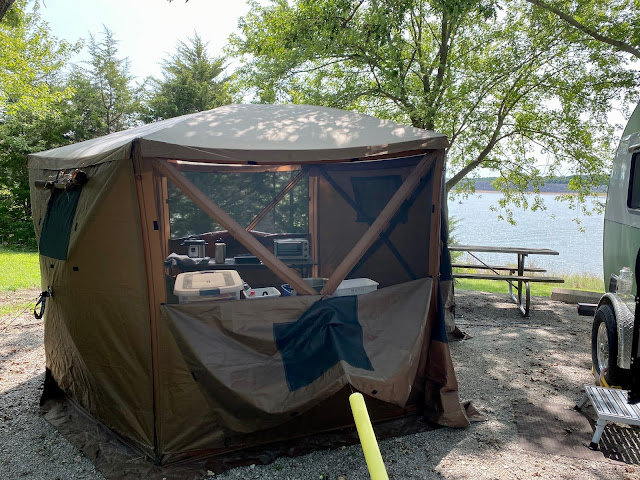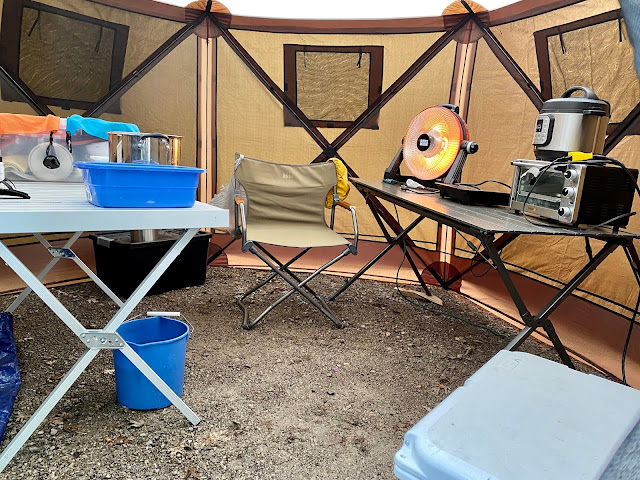 |
| Airstream Basecamp and Nissan Pathfinder, which will be my set-up |
Not that we're on pins and needles, but my wife and I are expecting the delivery of our 2021 Airstream Basecamp to RV One in Des Moines in January, four months from now. Of course we're not excited! If I were Pinocchio, my nose would have grown so long I couldn't get into the camper!
The Basecamp will be a move larger from our first trailer, a tiny standy trailer, a Rustic Trail Teardrop Camper, a Polar Bear model, which I bought used (one time!) three seasons ago. It's been a great trailer, but now I'm more experienced and confident with towing and backing a trailer, and a bit larger trailer will meet our family's needs better--mostly having more space for my wife's consulting work and for when we take the grandkids camping.
 |
| Our current RTTC Polar Bear with the Nissan Pathfinder |
We've found a way to be comfortable in our tiny trailer. There's not much room, but there's enough to have a comfortable night's sleep on our "bed on wheels." There's enough room to turn on the electric oil heater when the weather turns cold, as is happening now with the coming of October, and we've found the fall to be our favorite camping time after three seasons of tiny trailer camping.
With three years of trailer camping experience--and also with the research and interaction with other campers because of this blog--my wife and I are aware of the changes that owning the Airstream Basecamp will entail. These changes will increase our comfort but will also increase the complexity of our camping maintenance experience. The RTTC Polar Bear is beautifully basic, and by that I mean it's got inside 12v lights and a 15 amp, 110 plug-in. That's it! No water systems to worry about, or heating systems. No batteries or solar. It does have a small "window unit" air conditioner built in that helps with the Midwest heat and humidity. It's so simple and free of maintenance.
However, and it's a big however, the greater complexity of the Basecamp will provide greater comfort for us. The "us" is a very significant word. My wife and I both agree that the RTTC camper is a much easier experience with just one person. My wife hasn't camped alone in it, but we've both been alone inside the unit enough (and together in the unit enough) to have realized and discussed the advantages of having a small trailer rather than a tiny trailer, a small trailer with the bells and whistles that maximize the utility and comfort of that slightly larger space.
 |
| Basecamp interior |
Our camping experience so far has been almost exclusively in the Midwest, except for one trip by me to the Carolinas last year. Our Midwest experience determined for us the Basecamp configuration we ordered so that we could have the best fit for our camping needs, yet still have the flexibility for new experiences and new vistas. There is very little boondocking in the Midwest, at least in Iowa. Almost all camping is in established campgrounds, from larger federal Army Corps and state parks to smaller county, city, and private campgrounds. Almost all have electricity, available water, dump stations, and at least pit toilets. The closest equivalent to Midwest boondocking in experience are the primitive campgrounds, campgrounds that provide a pit toilet and a picnic table and fire ring. Some also have a water spigot available somewhere in the campground.
 |
| The Basecamp is a big step up for us in space! |
The Airstream Basecamp package my wife and I chose reflects our Midwest camping experience--where at least for the next few years we will continue to camp. We didn't opt for the BCX option with greater camper lift and rock guards up front, since almost all our towing will be on pavement with a bit on established gravel roads. We didn't opt for solar since almost all our camping will have shore power, and because the Basecamp is wired with a zamp plug so we can buy a portable solar package when we need it. We're confident that the standard Basecamp's height from the ground will be plenty for our travel, even if we get off the road a bit. As for solar, we tend to look for shaded campsites, so the portable solar package seems to be the best option, and it's about half the price of the roof package.
 |
| Basecamp using the portable solar option |
Our main question right now regarding our basic set-up is if our two AGM batteries will be enough to keep our 12v refrigerator cold if we drive for two days to a destination, spending one night in a parking lot. From what we've been told, our chosen options will meet that test. The new 12v refrigerators have a low pull, and I'm making sure that my factory Nissan Pathfinder tow package includes the trailer battery charge capacity while we're towing. I'll be having our brake controller installed in a month at our local Nissan dealership, and they're going to double-check the battery connection on the 7-pin plug to make sure it is set up to charge a trailer battery.
Questions I Have
Right now I'm following AS Basecamp online groups to find out all those little additions owners have discovered that will enhance our camping experience. I'm also in the process of connecting with Basecamp owners and our Airstream dealership to gather information about our upcoming purchase. Here is some of the information I've either gathered or am in the process of gathering.
- Security: Yesterday I called customer support at Proven Industries to find out what particular receiver coupler lock fits the Basecamp. RV One told me the hitch ball was 2 5/16". The technician told me that AS has its own receiver, and that the company has a lock to fit: Model 2516. I can now purchase the security coupler lock and have it in advance of our trailer purchase. In addition to the coupler lock, I also own a Trimax wheel lock; however, I'll have to continue my research to see if the one I own will fit the Basecamp's tires.
- Cellphone Signal Strength: My wife has a consulting business, much of which takes place online. As with our current tiny standy trailer, the Basecamp will sometimes be a mobile office. I'm researching whether or not the aluminum trailer will dampen the cellphone signal strength for calling or using as a hotspot. My wife and I do use a WeBoost signal booster when necessary. I've asked about receptivity inside the Basecamp on an online AS Basecamp group and have received conflicting views, from there being no problems to stating the Airstream acts as a giant Faraday cage. I'm going to move this discussion to a more personal one with AS owners I have contact with.
- Owner Hacks: I have been keeping track of little modifications and additions to the standard Basecamp that owners have used, from strip lights to hooks. The Tails of Wanderlust Basecamp owner has provided a couple of good articles of under $25 accessories and on kitchen accessories that are informative. I've also followed a couple of group posts regarding stick-on hook placement and storage boxes, but mainly my wife and I will just be living in the trailer for a while and then deciding what "hacks" we will incorporate.
- Off-grid Mobile Office: We are researching how to power my wife's mobile office workspace when off the grid. There are four units to power: laptop, small 2nd screen, WeBoost signal amplifier, and cellphone, all of which add up to just under 100 watts. Although the draw of power and the battery load (with Zamp solar panels) is something we will just have to gauge from experience, my basic question at this point is whether I will need to have a car-type 12v plug-in installed when I pick up the trailer so that I can use an inverter to change the 12v power to 110 for the electronics.
 |
| Looking forward to new experiences |
Being more knowledgeable and experienced travel trailer owners now as we move toward ownership of our second trailer, my wife and I are looking forward to the process of becoming familiar with the Basecamp. It's greater options and complexity will present us with a learning curve, but we feel confident that living with more possibilities that better meet our personal needs will be an exciting and rewarding time. If any Basecamp owners have suggestions or observations, please feel free to provide them. Thanks!
|
|




















